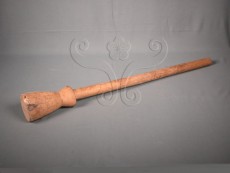|

Introduction
Tools used in food processing included the wooden mortar, pestle (made from wood or stone), steamer, cooking pots and containers. The main materials used to make these tools were wood, stone and rattan. The wooden mortar and pestle were used together to husk rice, to make sticky rice or to grind millet or peanuts. Pestles are divided into single wooden pestle, double wooden pestles and stone pestle. They were usually used together with a square wooden mortar.
Traditionally, the mortar and pestle were essential household items for every Amis family. Now, these tools areused in special ceremonies, such as the Harvest Festival, cultural tourism activities and exhibitions.
Description
Pestles are made from logs that are cut and pared. The shape is simple. The top part is long and thin to form the handle. The body of the pestle is straight all the way to the bottom part which is cylindrical in shape. The bottom is the part used for pounding grain.
Production methods
Tools for grinding grain were made by paring hard wood. During the production, a section of log was cut and formed into a stick shape. There are no indentations or carved decorations on the body of the pestle. The bottom part used for grinding is cylindrical in shape.
Uses
Grinding tools are used for removing the husks from millet.
The pestle and mortar are the most basic tools for processing grain. There was a time, when traditional agricultural production methods were in use, that almost every Amis family had one or several wooden mortars and pestles. The mortar and pestle were the most basic and essential tools. When a family moved to another location, they would take their mortars and pestles with them.
Pestle and mortar were used together during the grinding of grain. Two to three Amis women at a time would do the grinding. The women who were experienced in the grinding process would set the rhythm of the pestle movements.
National Museum of Natural Science
|